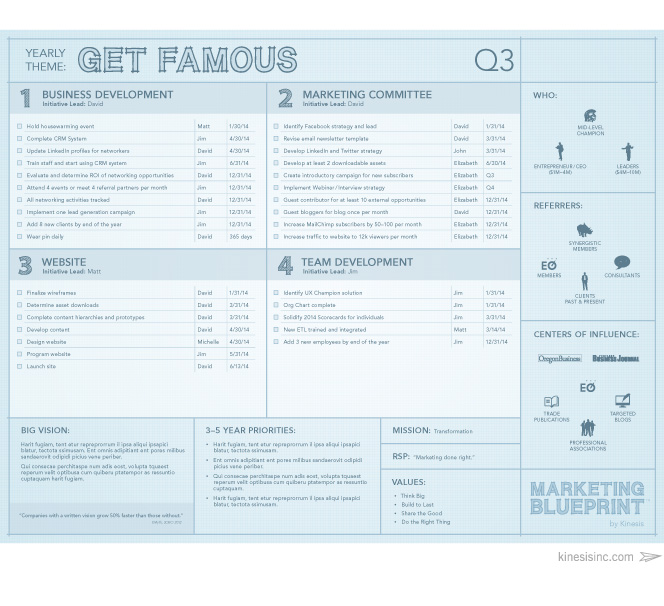
Three options to fill your marketing function
Growing businesses have several options when it comes to filling their marketing need. Learn the pros and cons of each approach.
If your company has an annual marketing plan, then you are ahead of the game. According to EMyth’s SOBO (State of the Business Owner), less than half of small businesses owners report actually having a written marketing plan for their company.
And who could blame them? Marketing plans are notorious for taking up hours of energy once a year, and then gathering dust for 51 weeks. So it’s not surprising that a majority of business owners forego it.
This is unfortunate, however, since the same report (which surveyed more than 800 business owners in 47 different countries) uncovered that companies with a written marketing plan saw 30% faster growth than those without. And those with a written company vision grew 50% faster.
Stats like those are hard to ignore. With the year-end fast approaching, now is the time to set your marketing budget, establish objectives, and put forth the plan that will shape your growth.
…No pressure.
If you’re like some small business owners, you might be wondering what the term “marketing plan” is even referring to.
Simply put, a marketing plan outlines what annual marketing results you’d like to achieve, and how you plan to get there.
A great marketing plan would also include details like your target market, competitive positioning, and key differentiators.
In theory, a marketing plan is a great preparation and accountability tool. In practice, however, it is more often a cumbersome and impractical chore. Which is why at Kinesis, we’ve thrown the tired marketing plan of the past out the window, and replaced it with a single-page, editable working document—designed to help your team execute and keep an eye on the prize. We call it the Kinesis Marketing Blueprint™. And the way we see it, it requires a few key fundamentals:
 Developing your marketing strategy
Developing your marketing strategyThe first step to writing your marketing plan is to identify your key marketing objectives, and build a strategic framework around them. Start by asking, “Where would I like to see the company a year from now?” and then work backwards. What is standing between that goal and where the company is today? What steps can you take tomorrow, a month from now, six months from now to close that gap? These questions are the foundation for a larger strategic discussion that will help shape your marketing plan.
It’s tempting to wave off a marketing plan with the simple declaration of “What we’re doing is working.” This is great news, but unfortunately doesn’t get you off the hook—as it still doesn’t negate the need to think strategically about the future. Evaluating successes is just as important as evaluating failures—if not more so.
If you find your team along this train of thought, ask yourself: How are you measuring your marketing success? What specifically is working? Why? Has this strategy always worked for you? Is it likely to continue to be successful in the future?
Perhaps more importantly, is there anything that isn’t working? You may be happy with overall performance, but that doesn’t mean every tactic employed during the year should be repeated. What mistakes were made, and how can you avoid them next year?
Then, zoom out and examine what other business opportunities might have been previously overlooked or deemed irrelevant. Certainly your company isn’t in the exact same position as it was a year ago. What’s different? Has the company grown in size? Seen a change in leadership? Any shift in business offering? How does this affect your strategic direction looking into next year, and how can you adjust your marketing plan to reflect this?
Once you’ve determined your strategic objectives, the next step is to calculate your marketing budget and allocate resources. Depending on your specific goals, this calculation can yield a wide range of results. For instance, a company looking to rebrand or invest in a new website, is likely to look a lot different than a company with modest growth goals and well-established brand awareness.

But marketing initiatives aren’t the only determining factor—as investment is also affected by industry, company size, and competitive landscape. And of course, all marketing should be viewed as a profit center, not a cost center—and therefore setting the budget for any marketing effort should be based on the potential return of that effort.
(For more helpful tips, read Wendy Maynard’s recent post: “The Right Way to Set a Marketing Budget.”)
Asking these tough questions is absolutely vital to realizing your business goals. Why? Because you’ll be hard-pressed to find any marketing strategy that worked five years ago and is still serving you well today. In fact—fully half of successful marketing tactics this year will be deemed ineffective next year.
The nature of marketing (for that matter, the whole business world) is fickle, fluctuating, and temporary. Technology evolves, trends rise and fall, as do customer preferences and expectations.
A marketing plan presents the annual opportunity to reevaluate and realign your marketing approach.
Without a marketing plan, stale strategies are likely to lead to underwhelming results… to the tune of bleak revenues and stunted company growth. And you’ll be scratching your head wondering how it happened, because what you were doing was working.
(For more information on the fluctuating nature of marketing, check out Shawn Busse’s recent post: “Why Your Marketing Isn't Working.”)
With the pressure to improve business performance ever-present, marketing plans are often a source of stress and frustration for business owners. And it’s no wonder—strategic thinking is hard. When day-to-day operations consume all your time and energy, lifting your head to think big picture is easy to forget.
This year, we challenge you to take a step back, evaluate business potential, and start to think strategically about your marketing.
Are you a business leader, and need help developing a marketing plan for your service-centric company? Fill out the form below to schedule your free, 30-minute marketing assessment.
Get insights like this straight to your inbox.